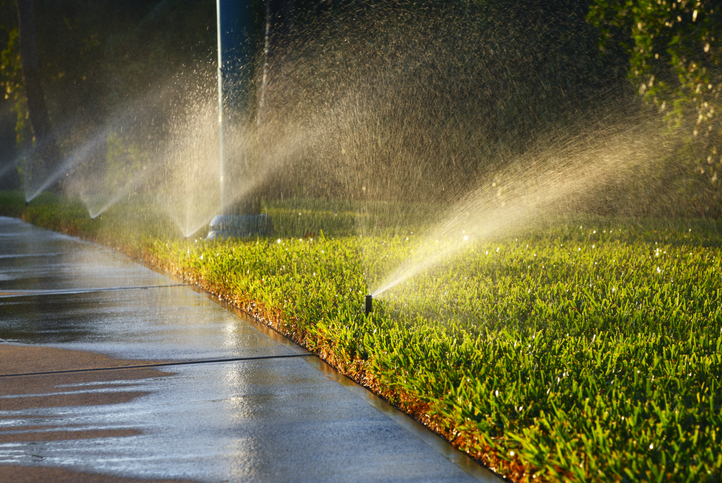Your landscape design is made up of many different kinds of plants. And different plants require very different methods of irrigation that deliver the proper amount of water to keep them healthy.
Matching the right type of sprinkler head to certain groups of plant species will optimize your Water Use Intensity. This perfect match will also prevent overwatering, which will damage your plants, and prevent wasteful runoff. According to current research, homeowners can save 50-70% of their water bill just by using the correct sprinkler heads in different zones of their landscape.
There are three basic sprinkler head types– Spray Irrigation Heads and Spray Rotary Sprinkler Heads, Bubbler Irrigation Heads, and Drip or Soaker Systems.
Each different sprinkler head will water your plants in the particular way they like. Choosing the right sprinkler system design for your lawn will depend on the size of your lawn, and also the water pressure your irrigation system design operates on.
Spray Irrigation Heads
These sprinkler head types work best for small to medium-sized lawns, as they distribute water evenly. If your water pressure is between 20-30 PSI, spray head sprinklers should be placed no farther than 15 feet apart, but with overlap for full coverage. Placing spray heads farther than 15 feet apart would create dry spots in your lawn.
Spray irrigation heads put out a lot of water fast and give a fine, misty spray that can be blown away. This will affect irrigation efficiency, so it may not be a good choice if you live in a windy area.
Rotary Sprinkler Heads
These sprinkler heads are best used for medium to large lawns with an irrigation system that supplies a PSI above 30. The distance between each rotary head placement should be less than the PSI supplied to each one. Rotary heads are best for slow-draining soils and slopes, as they deliver water slower than spray heads in a stream, instead of a fine mist like spray heads do. This means no wind drift of spray, less runoff and less wasted water.
Bubbler Irrigation
This type of irrigation delivers a lot of water fast, to pool in small spaces around shrubs and trees, and in ground cover. Bubblers are not used to water lawns. Bubblers should not be used in areas that are not level, or in soil that doesn’t drain quickly (such as clay), as water will run away from plants and flood other areas.
Drip Irrigation and Soaker Systems

For extensive landscapes, a drip irrigation system is recommended instead of using lots of bubblers. Drip irrigation delivers water slowly to plant bases and is much more efficient for large landscapes. Flower beds and crops do well with drip irrigation.
If using bubbler irrigation and drip irrigation, each should be placed on their own zone, and not connected to the same irrigation valve setup that runs spray heads or rotary heads. If everything is set for one zone, some plants will be over-watered, and some under-watered, because of different water applications.
Sprinkler heads can be mixed and matched to different groups of plants in your landscape design, as long as those different sprinkler heads are installed in separate zones. Spray heads deliver water twice as fast as rotary heads, so the flow of water must be controlled to prevent under or over watering different plants.
Smart Irrigation Controllers
When using a mix of sprinkler heads, a Smart Irrigation Controller such as WeatherTRAK ET Pro3® can easily separate your landscape into different watering zones. This cloud-based smart controller is then programmed to water each different zone at different times and for different lengths of time, depending on each plant grouping’s needs.
WeatherTRAK ET Pro3® smart irrigation controller uses Evapotranspiration, the most precise, high-resolution weather data available, to create specific schedules to maintain your landscape health with the least amount of water possible.
Matching the correct arrangement of sprinkler head types to different plant groupings will not only result in a healthy, flourishing landscape, but eliminate wasteful runoff to substantially reduce your landscape’s water consumption.

